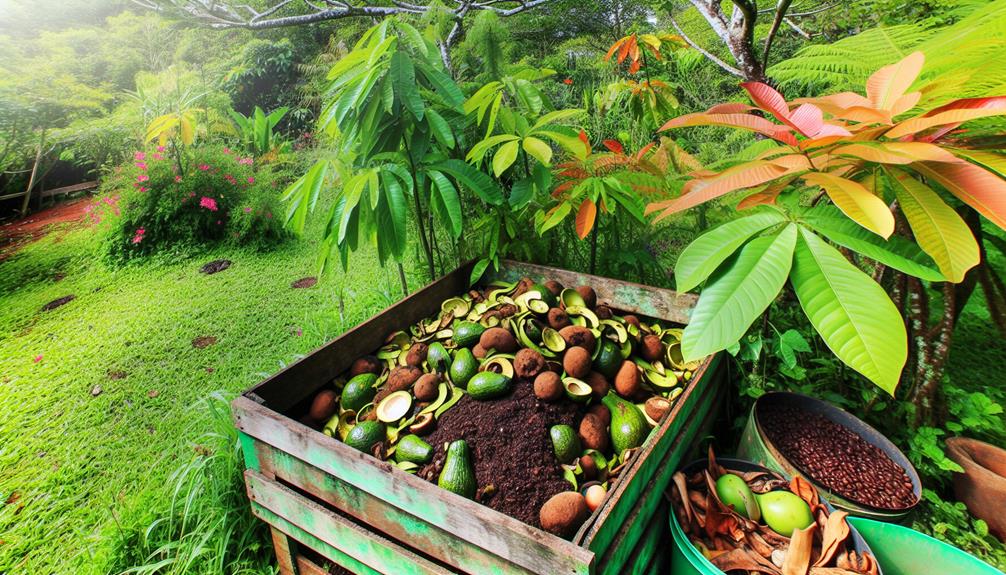

Yes, you can compost avocado. To do it correctly, chop the peels and leftover flesh into smaller pieces, and break the pits into chunks using a hammer for quicker decomposition. Make sure avocados are free of oil and seasonings. Add these bits to your compost bin along with other green and brown materials, maintaining a balanced ratio.
Turn the compost regularly to aerate and help speed up the process. By composting avocados, you enrich the soil with nutrients like potassium and magnesium, improve soil structure, and reduce kitchen waste. Keep going to discover more practical composting tips and tricks.
Avocado composting basics will guide you through turning avocado scraps into nutrient-rich compost. Start by collecting avocado peels, pits, and any leftover flesh. Chop the peels and flesh into smaller pieces to speed up decomposition. The pit should be broken into smaller chunks with a hammer.
Add these avocado bits to your compost bin, mixing them with other organic materials like vegetable scraps, coffee grounds, and yard waste. Maintain a balanced ratio of green (nitrogen-rich) and brown (carbon-rich) materials for best composting results. Turn the compost pile regularly to aerate it, ensuring even decomposition.
Keep the compost moist but not soggy. With patience and proper care, you’ll transform avocado waste into valuable compost for your garden.
When you compost avocados, you enrich your soil with essential nutrients, promoting healthier plant growth. This practice also helps reduce kitchen waste by turning discarded avocado parts into valuable compost material.
You’ll find that incorporating avocados into your compost can greatly benefit your garden and the environment.
Composting avocados enriches your soil with essential nutrients, boosting plant growth and health. By adding avocado scraps to your compost, you provide a variety of benefits to your garden. Here’s what you can expect:
Incorporate avocado compost into your garden to enjoy these benefits and support your plants’ growth and vitality.
By verifying that avocado peels and pits are free from oils or seasoning, you greatly reduce kitchen waste and promote a more sustainable lifestyle.
Start by collecting avocado peels and pits. Be sure they’re free from oils or seasoning.
Chop the peels into smaller pieces to speed up decomposition. The pits, being quite tough, can be broken down with a hammer or left to decompose longer.
Add these to your compost bin, balancing them with green and brown materials like vegetable scraps and dried leaves. Turn the compost regularly to aerate it.
This practice not only minimizes waste but also reduces your carbon footprint. You’ll transform what could be landfill material into nutrient-rich compost, beneficial for your garden and the environment.
Avocado flesh breaks down quickly and enriches your compost with valuable nutrients. When adding it to your compost, make sure to cut the flesh into smaller pieces to speed up decomposition.

Dealing with avocado skins in your compost requires a bit more time and effort due to their tougher texture. Start by cutting the skins into smaller pieces. This increases the surface area and speeds up decomposition. You can also consider shredding or grinding them if you have the tools available.
Mixing these smaller pieces with softer compost materials helps balance the compost pile and promotes faster breakdown. Ensure your compost pile maintains the right balance of greens and browns. Avocado skins are considered ‘greens,’ so mix them with carbon-rich materials like dry leaves or cardboard.
Turn your compost pile regularly to maintain aeration and moisture levels. With patience and these steps, avocado skins will eventually break down, enriching your compost.
Unlike avocado skins, avocado pits demand a slightly different approach to guarantee they decompose effectively in your compost. Their dense, hard nature means they take much longer to break down.
Here’s how you can help speed up the process:
To get your avocados ready for composting, start by removing any stickers and cutting them into smaller pieces. This step is important because smaller pieces decompose more efficiently. Make sure to cut through the skin and flesh, breaking them down into manageable chunks. You don’t need to peel the avocados; the skin is compostable too.
Next, check for any large or hard bits that might take longer to decompose. If you find any, consider chopping them further. Confirm your avocados are free of any non-organic materials like plastic or rubber bands.
Once prepared, you can add them to your compost pile. Mixing them well with other compostable materials will help maintain balance and promote effective decomposition.
To accelerate the decomposition of avocado scraps, begin by shredding them into smaller pieces.

Guarantee your compost pile maintains ideal moisture levels, as too much or too little water can impede the process.
Furthermore, balance the green (nitrogen-rich) and brown (carbon-rich) materials in your compost to create a perfect environment for decomposition.
Shredding avocado peels and pits into smaller pieces greatly speeds up their decomposition in the compost pile. When you break them down, you increase the surface area, allowing microorganisms to work more efficiently.
To shred them effectively, you can use a kitchen knife, a food processor, or even a garden shredder.
Maintaining ideal moisture levels in your compost pile is essential for accelerating the decomposition of avocado scraps. Aim for your compost to feel like a wrung-out sponge; not too wet, not too dry. If it’s too dry, decomposition slows down, as microorganisms need moisture to thrive. Conversely, excessive moisture can lead to anaerobic conditions, producing unpleasant odors and slowing the process.
Regularly check your compost by squeezing a handful; it should hold together but not drip. If it’s too dry, add water and mix well. If it’s too wet, incorporate dry materials like shredded paper or straw. Balancing moisture will create an optimal environment for breaking down avocado scraps efficiently, speeding up the overall composting process.
Achieving the right balance of green and brown materials in your compost pile is essential for speeding up the decomposition of avocado scraps. Green materials, like avocado peels and pits, provide nitrogen, while brown materials, such as dried leaves, supply carbon. Aim for a ratio of roughly 2:1 browns to greens to optimize microbial activity.
Here are some tips to maintain this balance:
Following these guidelines will help you compost avocado efficiently and effectively.
When composting avocado, you’ll need to watch for potential issues like pest attraction and slow decomposition. Avocado pits and skins are tough, making them decompose more slowly than other kitchen scraps. This can lead to an imbalance in your compost pile if not properly managed.
To mitigate this, make sure you chop avocado parts into smaller pieces to accelerate the breakdown process. Additionally, the rich, oily nature of avocados can attract pests such as rodents and insects. To avoid this, always bury avocado scraps deeper within your compost pile, rather than leaving them on top.
To get the most out of composting avocado, make sure to chop the skins and pits into smaller pieces to speed up decomposition. Avocado skins and pits are dense and can take a long time to break down, so reducing their size helps microbes work more efficiently. It’s also beneficial to mix avocado waste well with other compost materials to guarantee even breakdown.
Here are some additional tips:
Following these tips will help you compost avocado more effectively.
Combining avocado waste with a variety of other organic materials can enhance the efficiency of your composting process. Start by mixing avocado peels and pits with green waste like vegetable scraps and grass clippings, which provide nitrogen. Balance this with brown waste such as dry leaves, cardboard, and paper, which add carbon.
Guarantee a good mix to promote aeration and microbial activity. Chop larger pieces of avocado waste for quicker decomposition. Turn your compost pile regularly to maintain oxygen flow and monitor moisture levels—aim for a consistency like a damp sponge.
Here are more such articles that you should read:
What To Do With Old Clothes: Genius Ideas You’ll Love!
Can You Recycle Pizza Boxes? Here’s What You Need to Know!
Maggots in Compost: Why They’re Actually Good!
Composting Corn Cobs: Your Ultimate Eco-Guide
Composting avocados is straightforward if you handle each part correctly. Incorporate the flesh, manage the skins, and crush the pits to speed up decomposition. Watch for potential issues like pests or slow breakdown.
Mix avocado waste with other compostable materials to balance nutrients. Following these tips, you’ll effectively turn avocado waste into valuable compost for your garden. With a bit of attention, your compost pile will thrive and benefit your plants.
